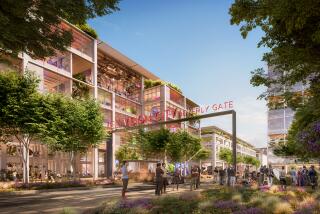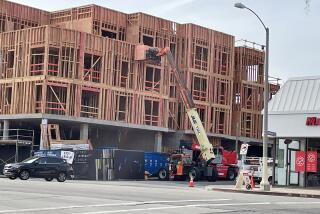Ventura Blvd. Revitalization Gets Green Light
- Share via
Ending a five-year struggle to overhaul Ventura Boulevard, the Los Angeles City Council took action Tuesday that will launch a long-awaited revitalization of what is considered the San Fernando Valley’s “Main Street.”
The council’s vote approves new developer fees to pay for the revitalization plan and puts an end to years of protest and debate between residents and developers along the 17-mile thoroughfare.
The plan--formally known as the Ventura Boulevard Specific Plan--is designed to set growth limits while imposing business fees to pay for traffic improvements, parking, shuttle vans and themed landscaping along the street.
To jump-start the improvements, the council set aside $250,000 to pay for amenities to attract pedestrian shoppers. Some improvements already suggested include tree-lined jogging trails, bougainvillea-covered canopies, Art Deco street lights and neon palm tree sculptures.
The plan was originally adopted in 1991 after the heady growth years of the 1980s and relied mostly on development fees for its $222-million budget.
But after five years of protests by developers and the discovery of an error in calculating the fees, the city and business owners agreed to revise the plan by simplifying and reducing fees for developers by more than 75%.
Developers and business leaders had complained that the previous fees had stifled growth along the boulevard. The new fees will drop from an average of $11.43 per square foot to $2.75 per square foot.
The new plan has a budget of $63 million for the first phase, with most of the funding coming from local and regional transit funds. That phase will include transportation and landscaping improvements. A second phase would cost an additional $112 million but fees for that have yet to be considered.
Homeowner groups support the overhaul because it keeps in place previously approved development restrictions, such as density and height limits.
“We are hoping that this new system will lead to a revitalization,” said Richard Close, president of the Sherman Oaks Homeowners Assn. “This is our main street and we want it improved.”
Council members who represent parts of the boulevard praised the revision as a win-win compromise that resulted from years of community workshops and debates.
“This represents a true and good compromise and a good plan for Ventura Boulevard,” said Councilwoman Laura Chick, whose staff spearheaded the overhaul.
Councilman Marvin Braude, who represents parts of the West Valley, agreed. “This started out as an experiment but has become a role model for the whole city.”
Under the plan, new development cannot exceed 4.1 million square feet of growth until $17 million in street widening and other traffic improvements are installed on the boulevard to accommodate the resulting traffic increases.
In addition, the new plan tries to spread the cost of street improvements by forming five business improvement districts along the boulevard to collect fees from existing businesses.
The overhaul also strikes out the controversial trip fees on developers that were based on the number of vehicle trips generated by new projects. Instead, fees will be based on the floor area of new projects.
“It will be a great benefit to all those along Ventura Boulevard that this be adopted,” Fred Gaines, an attorney for six property owners along the boulevard, told the council.
“Everyone is in support of this plan,” said Jeff Brain, chairman of a citizens panel that helped draft the plan.
Under the previous plan, most of the cost of traffic improvements along the boulevard were borne by developers. But as the development boom dried up in the late 1980s and developers appealed the fees, the city found it was able to collect only a fraction of the payments.
The revised plan reduces the total contribution of developers from $101 million to $11.3 million. To make up the difference, the city will use funding from local, regional and state transit dollars.
The adoption of the overhaul also allows the city to begin issuing refunds to developers who paid the previous fees.
But the seemingly harmonious adoption of the changes was almost wrecked when city planners suggested that developers who built on the boulevard between 1985 and 1996 be required to pay retroactive fees that would be 6% higher than those paid by developers who build in the future.
The increase was to pay for the $250,000 in street landscaping improvements.
Gaines said a conflict was averted when planners decided at the last minute to instead increase fees for all development--past and future--by 1% to 2%.
(BEGIN TEXT OF INFOBOX / INFOGRAPHIC)
The Ventura Boulevard Specific Plan sets guidelines to ensure that the pace of development does not cause excessive traffic problems on the 17-mile thoroughfare.
The 20-year plan, as originally adopted in 1991, had a $222-million budget, most of which was to come from fees on new developments. The fees were to be calculated based on the number of vehicles trips generated by each new project and were to pay for traffic improvement projects. But due to protest from developers and the discovery of an error in calculating the fees, city officials, business leaders and residents have proposed a revised $75-million plan.
Here are some key elements of the plan:
To simplify the process, fees for new development will be based on the floor area of projects instead of vehicle trips. The fees will help pay to widen 19 intersections, add hundreds of parking spaces along the boulevard and add shuttle buses and ridesharing programs.
The fees will range from 56 cents to $4.51 per square foot of floor area, depending on the community and type of project. An additional fee will be added for projects with drive-through windows, such as restaurants and banks.
Business improvement districts are being formed throughout the boulevard to collect fees from existing business to pay for landscaping and other improvements that would promote pedestrian traffic.
Height limits for new development would range from 30 feet to 45 feet, depending on the area and project. The plan will also set guidelines for size of side, front and back yards.
More to Read
Sign up for Essential California
The most important California stories and recommendations in your inbox every morning.
You may occasionally receive promotional content from the Los Angeles Times.










